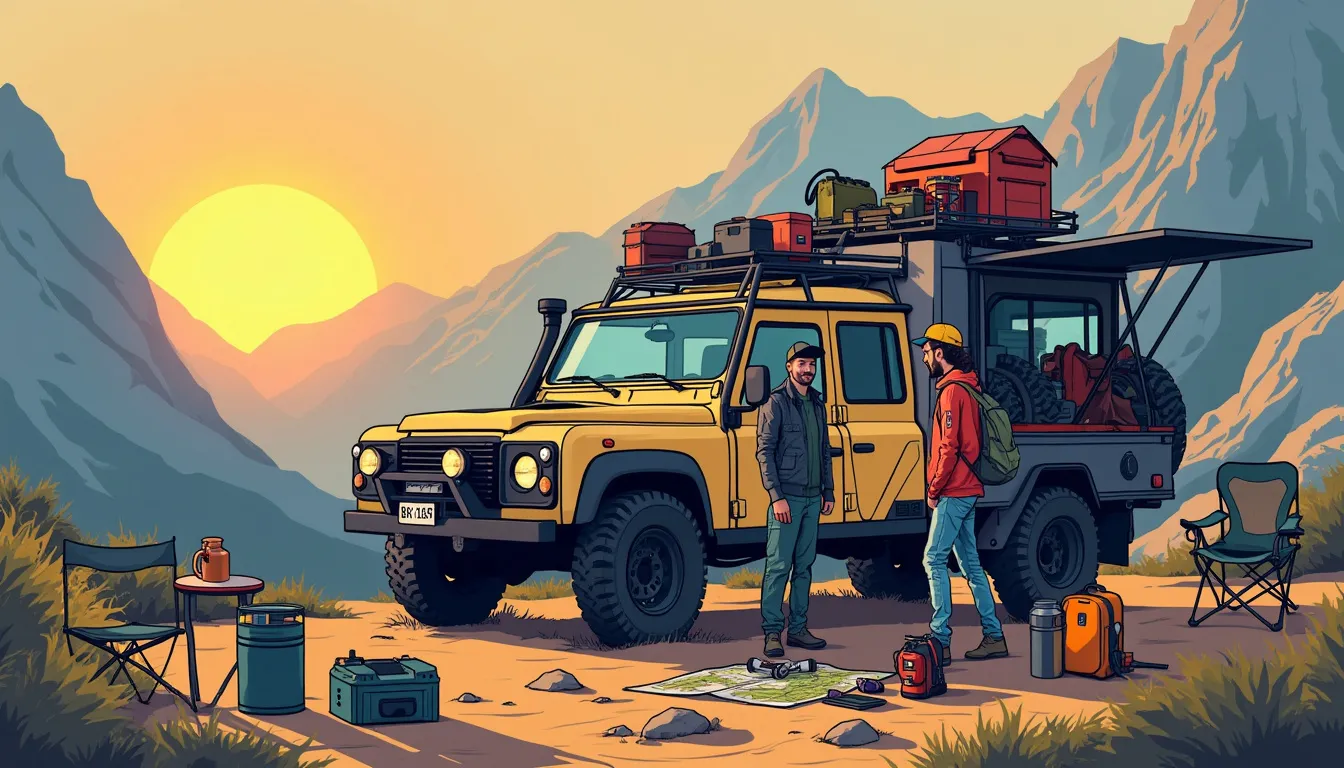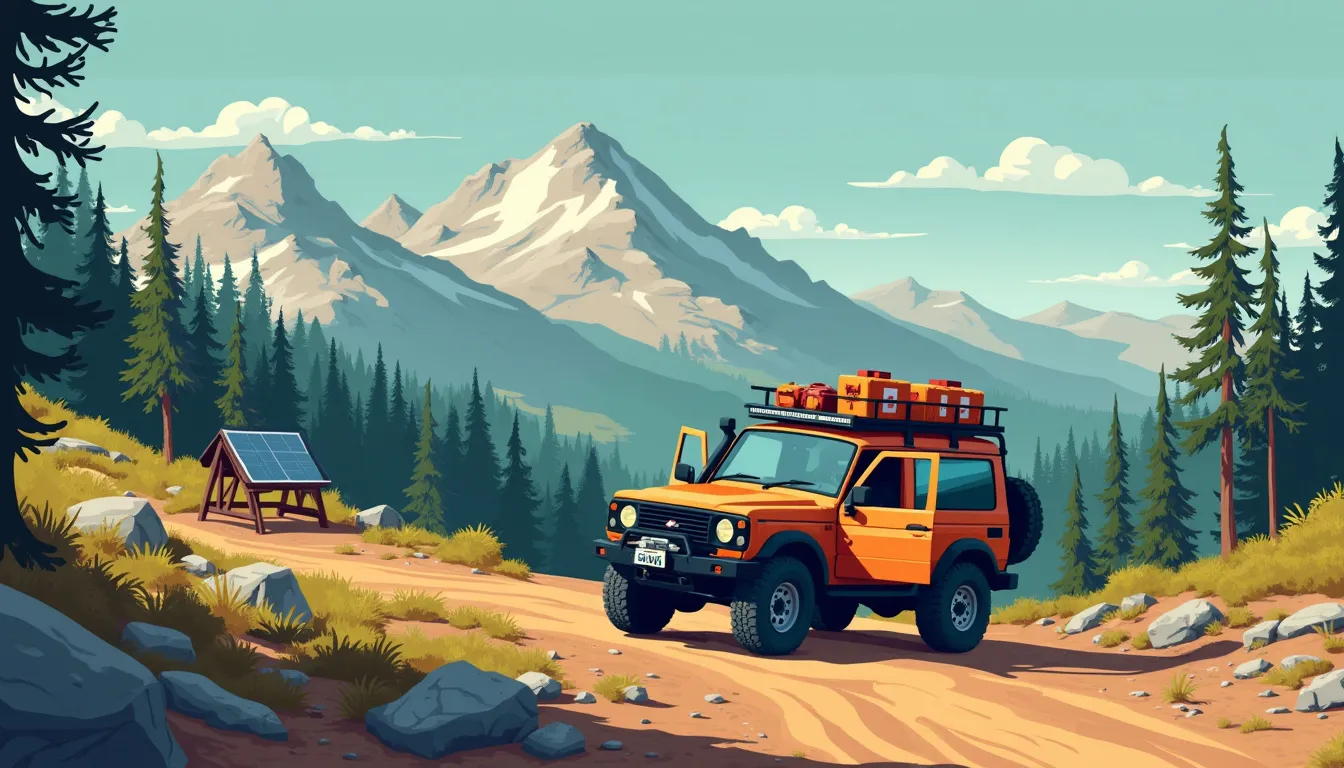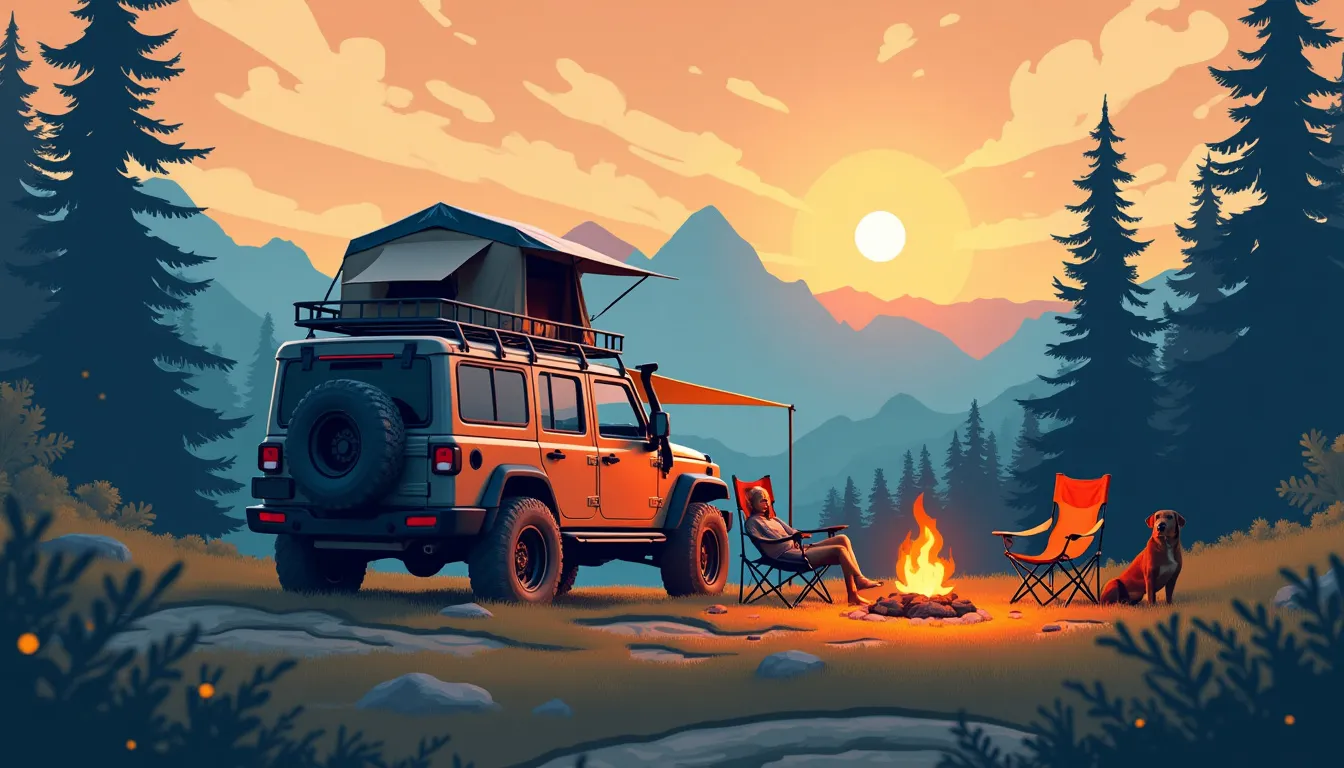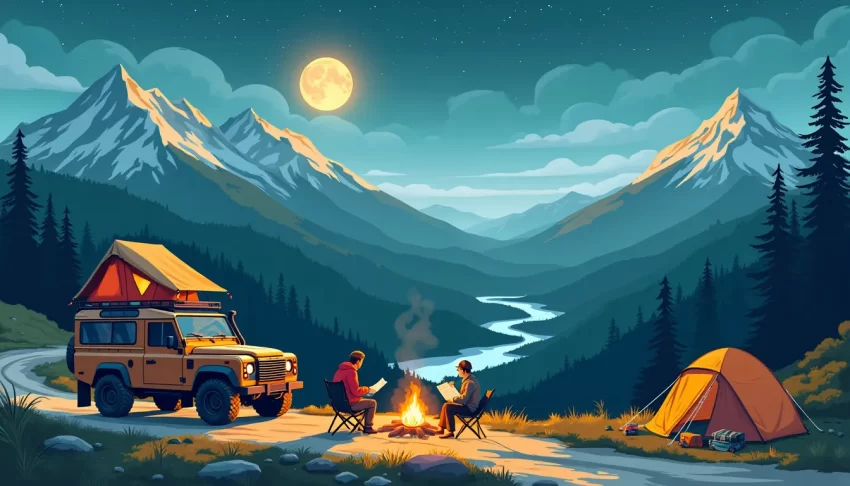Embarking on an overlanding adventure is more than just a journey; it’s an exhilarating commitment to explore the uncharted territories of the world, blending the thrill of travel with the ruggedness of off-road expeditions. Whether you’re a seasoned traveler or a novice seeking to break free from the humdrum of daily life, understanding overlanding tips and best practices is crucial to making the most of this unique adventure. Overlanding, a method of self-reliant travel to remote destinations where the journey is the principal goal, has roots that stretch back to early expeditions in Australia and Africa. These voyages emphasized resilience, resourcefulness, and a deep connection with the natural world—values that continue to define modern overlanding.
But why choose overlanding as your next adventure? The benefits are numerous. Overlanding offers unparalleled freedom, allowing you to venture off the beaten path and witness breathtaking landscapes that commercial travel often overlooks. It encourages a minimalist, yet meticulous approach to travel, demanding that you pack only the essentials while still being prepared for whatever the wild throws at you. Furthermore, overlanding fosters a sense of community among fellow adventurers who share a passion for exploration and self-sufficiency.
In this article, we will delve into the essential overlanding tips and best practices that ensure a safe, enjoyable, and enriching experience. From preparation and planning to safety and sustainability, we will cover all facets of overlanding to equip you with the knowledge you need. You’ll learn about the essential gear and equipment that can make or break your journey, tips for preparing and maintaining your vehicle to withstand the rigors of off-road travel, and the importance of thorough route planning coupled with reliable navigation tools. Additionally, we will highlight strategies for staying safe on the road, promoting eco-friendly practices, and effectively handling emergencies.
For those looking to enhance their overlanding experience, we’ll offer guidance on maximizing comfort and enjoyment, connecting with the vibrant overlanding community, and sharing your adventures with friends and family. These insights are not just theoretical; they stem from a blend of historical wisdom and contemporary best practices, ensuring that you are well-prepared to tackle your overlanding pursuits with confidence and ease.
So, buckle up for a comprehensive guide that’s packed with practical advice, relatable stories, and a touch of wit to make your overlanding journey as rewarding and memorable as possible. Let’s get started and dive into the world of overlanding with the right tools, knowledge, and spirit for adventure.
Introduction to Overlanding: Understanding the Adventure
Definition and History of Overlanding
In the realm of adventurous travel, few experiences rival the excitement and profundity of overlanding. At its core, overlanding is a form of self-reliant adventure travel to remote destinations where the journey is the principal goal. Unlike conventional road trips or camping expeditions, overlanding emphasizes the independence of the voyage, allowing travelers to explore off-the-beaten-path locales and revel in untouched natural beauty.
Tracing its origins back to early 20th-century Australia, the term overlanding was used to describe the droving of livestock over vast distances. Fast forward to modern times, and the ethos has evolved to embody a spirit of self-sufficiency, discovery, and connection with the great outdoors. Whether it’s the expansive deserts of Africa or the rugged backcountry of North America, overlanding provides a gateway to uncharted adventures.
Why Choose Overlanding as Your Adventure
Consider the landscape of travel and adventure options available today—so why overlanding? The benefits are as varied as they are compelling. For one, overlanding offers unparalleled freedom. You’re not bound by airline schedules, hotel bookings, or tourist traps. Instead, you dictate your itinerary, exploring at your own pace and on your terms.
Moreover, overlanding fosters a deep and meaningful connection with nature. Picture yourself parked under a starlit sky, miles away from the nearest city, with only the sounds of the wilderness as your lullaby. This is not just an escape from the hustle and bustle of everyday life but a return to a simpler, more primal way of living. It’s no wonder that overlanding is lauded for its mental health benefits, providing a break from the constant digital noise and helping to reduce stress and anxiety.
From a practical standpoint, overlanding can also be surprisingly cost-effective. Once you’ve made the initial investment in vehicle and gear, your ongoing expenses often consist of fuel, food, and maybe the occasional campground fee. This makes it an attractive option for those looking to travel extensively without breaking the bank.
Overview of Essential Overlanding Tips and Best Practices
Embarking on an overlanding journey requires meticulous planning and preparation. Here are some essential overlanding tips and best practices to ensure a safe, enjoyable, and memorable adventure:
- Pre-trip Planning: Before hitting the road, conduct thorough research on your destination. Understand the terrain, weather conditions, local regulations, and any entry requirements if you’re crossing borders. Preparation is key to avoiding unnecessary surprises.
- Vehicle Readiness: Your vehicle is your lifeline on an overlanding trip. Ensure it’s in top condition with a full-service checkup. Equip it with off-road tires, a robust suspension system, and other overlanding essentials such as a roof rack, extra fuel cans, and recovery gear.
- Gear Essentials: From camping gear, cooking equipment, and first aid kits to navigation tools and emergency communication devices, packing the right overlanding gear is crucial. Opt for durable, lightweight, and multi-functional items to maximize efficiency.
- Sustainability: Embrace eco-friendly overlanding practices. Follow the Leave No Trace principles—pack out all trash, minimize campsite impact, and respect wildlife. Sustainable travel not only preserves the beauty of our planet but also ensures that future adventurers can enjoy the same pristine environments.
- Safety Measures: Prioritize safety at all times. Keep a well-stocked first aid kit and familiarize yourself with basic first aid procedures. Know your vehicle’s limits and drive cautiously, especially in unfamiliar or challenging terrains.
- Route Planning and Navigation: Utilize reliable navigation tools such as GPS, topographic maps, and compass. Plan your route with contingencies in mind—know alternative routes and have a backup plan in case of unexpected detours or road closures.
By adhering to these overlanding tips and best practices, you can embark on an adventure that is not only thrilling but also safe, sustainable, and deeply fulfilling. The spirit of overlanding lies in the journey itself, offering a unique blend of exploration, self-reliance, and a profound connection with the natural world. So, gear up, plan meticulously, and set forth on an overlanding expedition that promises endless discoveries and unforgettable experiences.

Preparing for Your Overlanding Expedition
Essential Gear and Equipment for Overlanding
Embarking on an overlanding expedition requires meticulous preparation, starting with gathering the right gear. Ensuring you have all the overlanding gear essentials can make the difference between a thrilling adventure and a logistical nightmare.
First and foremost, a durable and reliable tent is paramount. Opt for a rooftop tent for a combination of convenience and protection from ground-related hazards. I remember my first overlanding trip in rural Utah with a ground tent and waking up to discover fresh animal tracks surrounding the campsite—a rooftop tent became a must-have after that!
Equally crucial is a high-quality sleeping bag suited to the climate of your destination. An all-season sleeping bag can save you from unexpected cold snaps, and trust me, those can happen even in places you least expect. I once underestimated the night temperatures in Colorado’s summer, and a sleepless, shivering night taught me to always prepare for the unexpected temperatures.
Your overlanding kitchen should include a portable stove, fuel, and appropriate cookware. Consider carrying a multi-tool and a compact, folding table to enhance the outdoor cooking experience. A well-organized kitchen setup not only ensures you remain well-fed but also adds to the joy of camping. Eating a freshly made meal under the open sky is an experience every overlander cherishes.
Safety gear such as a first-aid kit, fire extinguisher, and a comprehensive survival kit should be non-negotiable items in your packing list. Having these essentials ensures you are prepared for emergencies, whether it’s a minor cut or a more serious situation requiring immediate action.
Vehicle Preparation and Maintenance Tips
Your vehicle is the heart and soul of your overlanding journey. Paying attention to vehicle overlanding tips is crucial in ensuring your adventure isn’t cut short due to avoidable mechanical failures.
Start by giving your vehicle a thorough inspection. Check fluid levels, brake systems, tire treads, and air pressure. It’s also advisable to carry spare tires, tools for basic repairs, and extra fluids like oil and coolant. During an overlanding trip in the Mojave Desert, a flat tire turned into a manageable hiccup rather than a trip-ending disaster, thanks to a well-stocked repair kit.
The next step is to fit your vehicle with the necessary overlanding modifications. Consider installing a beefy suspension system to handle rugged terrains and a snorkel if you plan on traversing through water bodies. However, don’t go overboard with modifications. Focus on practical enhancements that offer genuine benefits.
Another invaluable piece of advice is to familiarize yourself with your vehicle’s capabilities and limitations. Learning basic mechanical skills can save you time and stress in remote locations. I once found myself in the heart of the Yukon with a broken fan belt. Fortunately, a short roadside repair session, supported by my trusty vehicle repair manual, set me back on the trail within an hour.
Importance of Route Planning and Navigation Tools
The saying Failing to plan is planning to fail holds exceptionally true in overlanding. Effective overlanding navigation and planning are indispensable to ensure a smooth and enjoyable expedition.
Begin by researching your route meticulously. Utilize maps, apps, and guidebooks to chart your course. Topographic maps are especially useful for understanding the terrain you will be encountering. Knowing the lay of the land can help you avoid potentially hazardous areas and identify the best campsites. During a trip in the Australian Outback, pre-planning our route saved us from getting stuck in soft sand stretches that others, less prepared, struggled with.
Invest in reliable navigation tools such as GPS devices, satellite phones, and traditional compasses as backup. While modern technology is incredibly helpful, it’s crucial to have a non-digital backup in case your devices fail. On one isolated leg of a trip through Patagonia, our GPS malfunctioned but our trusty compass and map became our guiding lights through the desolate landscape.
Don’t forget to continuously update your plan based on real-time information. Weather changes, road conditions, and unexpected hurdles might necessitate adjustments to your original route. Having a flexible itinerary allows you to adapt seamlessly to these changes. Additionally, keep someone informed of your plans. Sharing your route details with a friend or family member can serve as a safety net if things go awry.
Preparation is the foundation of a successful overlanding trip. Equip yourself with the right gear, ensure your vehicle is in top condition, and plan your route meticulously. Remember, the effort you put into preparation directly correlates with the quality of your adventure. So gear up, prepare thoroughly, and let the open road beckon!

Safety and Sustainability in Overlanding
Best Practices for Staying Safe on the Road
Safety is paramount in any overlanding trip. Ensuring your personal and vehicular safety can mean the difference between a memorable adventure and a trip best forgotten. The core of overlanding safety lies in preparation and vigilance. Here are some indispensable overlanding safety tips:
Scout Your Route Thoroughly: Before hitting the road, research your chosen route meticulously. Make note of any potential hazards, difficult terrains, and remote areas where services might be scarce. Websites, forums, and overlanding communities are great resources for this information. My friend Julian once underestimated a river crossing in Utah. His enthusiasm quickly turned into a rescue mission that could have been avoided with better planning.
Regular Vehicle Checks: Your vehicle is your lifeline. Regularly check vital components such as tires, brakes, and fluid levels. Carry a basic toolkit and know how to perform essential repairs. One Saturday afternoon, I found myself wrestling with a flat tire on a desert track in Nevada – only to realize I had no spare. It was a lesson in vehicular preparedness I won’t forget.
Driving Techniques for Various Terrains: Adapt your driving to the terrain. For instance, when driving on sand, lower your tire pressure to increase traction. On rocky trails, keep a steady pace and avoid sudden maneuvers. I remember driving through the Rocky Mountains and the importance of maintaining low speed and momentum to navigate the sharp, winding paths – a true balancing act.
Communicate Your Plans: Always inform someone about your itinerary and expected return. Regular check-ins can be lifesaving. There was a time when a sudden snowstorm in the Sierra Nevadas left me stranded. Because I had communicated my plans, rescuers knew where to look, ultimately ensuring my safety.
Sustainable and Eco-Friendly Overlanding Practices
The allure of overlanding often lies in experiencing pristine nature. Preserving these environments is crucial for future adventurers. Here’s how you can overland sustainably:
Follow Leave No Trace Principles: This principle is not just about taking your trash with you. It entails minimizing your footprint in every aspect possible. For instance, set up camp on durable surfaces. A colleague of mine once pitched a tent on a lush meadow, unaware that it was a protected habitat. It caused considerable damage, a harsh reminder to always respect nature.
Sustainable Resource Usage: Be mindful of your resource consumption. Opt for solar-powered gadgets and energy-efficient appliances. During an extended overlanding trip, I relied on a small solar panel for charging electronics. It not only worked efficiently but also reduced my reliance on fuel-powered generators.
Human Waste Management: Proper disposal of human waste is integral. Use portable toilets and dispose of waste in designated dumping stations. I once encountered a beautiful, remote lakeside site marred by toilet paper and human waste – a stark reminder of the importance of responsible waste management.
Respect Wildlife: Observing wildlife from a distance ensures the safety of both the animals and yourself. During one trip, I stopped to photograph a herd of elk. A bit too close for their comfort, they got agitated. It was a scary moment that underscored the need to keep a safe, respectful distance from wildlife.
Dealing with Emergencies and Unexpected Situations
Despite meticulous planning, emergencies can happen. Being prepared can mitigate risks and manage unexpected situations effectively. Here are some overlanding emergency preparedness tips:
Carry a Robust First Aid Kit: Include items like bandages, antiseptics, pain relievers, and any personal medications in your first aid kit. Additionally, consider taking a first-aid course. I had a close call once when my travel companion got a nasty cut. Having a well-stocked first aid kit and basic knowledge made all the difference.
Recovery Gear and Know-How: Equip your vehicle with recovery gear such as winches, tow straps, and traction boards. More importantly, understand how to use them. On a particularly muddy trail in Oregon, I found myself stuck. Thanks to my winch and a fellow traveler’s guidance, I managed to pull free without much hassle.
GPS and Communication Devices: In remote areas, your cell phone might not work. Invest in a GPS device and satellite communicator. A GPS navigator once saved me when I got lost in the vast Mojave Desert. The peace of mind and security these devices offer is invaluable.
Have an Emergency Plan: Draft a plan outlining steps to take in various emergency scenarios. Practice these plans with your travel companions. During an overlanding trip, I faced a vehicle breakdown in a remote area. We used our emergency plan, which included rationing our supplies and sending out a distress signal, to stay safe until help arrived.
Incorporating these safety and sustainability best practices into your overlanding expeditions ensures not only an enjoyable adventure but also a responsible one. Overlanding isn’t merely about conquering miles; it’s about respecting the journey, the environment, and the communities we visit. Take these overlanding tips and best practices to heart and make your adventures safe, sustainable, and memorable.

Enhancing Your Overlanding Experience
Tips for Comfort and Enjoyment on the Road
Overlanding is not just about getting from point A to point B; it’s about the journey itself. To ensure that you maximize comfort and enjoyment throughout your trip, consider the following overlanding comfort tips:
1. **Ergonomic Seating and Sleeping Arrangements**: Long hours on the road can take a toll on your body. Invest in ergonomic seating for your vehicle, which includes bolstered seats with ample lumbar support. Additionally, don’t skimp on your sleeping setup. A quality rooftop tent or a well-insulated sleeping bag can make a world of difference.
2. **Climate Control**: Depending on your route, you may encounter various climates. Equip your vehicle with an efficient HVAC system or portable fans and heaters. For instance, during my trip through Death Valley, a portable evaporative cooler saved me from the sweltering heat and made the journey far more bearable.
3. **High-Quality Food and Cooking Equipment**: One of the joys of overlanding is cooking in the great outdoors. Carry a robust camping stove, utensils, and portable refrigerator. Pre-planning meals and having a variety of easy-to-cook recipes can make meal times a highlight of your day. Personalizing your overlanding experience can transform mundane routines into memorable activities.
Connecting with the Overlanding Community
The overlanding community is a vibrant, helpful, and inspiring group of people who share your passion. Here’s how you can connect and benefit from this invaluable network:
1. **Social Media and Online Forums**: Platforms like Instagram, Facebook, and dedicated overlanding forums (e.g., Overland Bound, Expedition Portal) are great places to share experiences, ask for advice, and gather inspiration. During my first overlanding trip, it was a Facebook group that saved me from a daunting mechanical issue by pointing me to a nearby reliable mechanic.
2. **Local Meetups and Events**: Participating in local overlanding events or meetups can be both informative and enjoyable. These gatherings often feature workshops, gear trades, and adventure storytelling sessions. Attendees can learn from each other’s experiences while forming lasting friendships. It’s heartwarming to recount how attending an overland expo connected me with like-minded adventurers who eventually joined me on several trips.
3. **Clubs and Organizations**: Joining overlanding clubs or organizations can provide structured support and exclusive insights. Such memberships often come with perks like access to premium content, organized travel routes, and networking opportunities with seasoned overlanders.
Sharing Your Overlanding Adventures
One of the most fulfilling aspects of overlanding is sharing your adventures with others, inspiring them, and keeping memories alive. Here are some effective ways to share your experiences:
1. **Documenting with Multimedia**: Whether you’re a fan of photography, videography, or writing, there are multiple ways to document your journey. High-resolution photos, engaging travel vlogs, or detailed blog posts can bring your adventures to life for those who weren’t there. Over the years, I’ve found that investing in a good camera and learning basic editing skills amplified the quality of my content.
2. **Storytelling Techniques**: Authenticity is key when sharing your adventures. Relate your experiences, both highs and lows, with honesty and a touch of humor. A well-told story can captivate your audience and make them feel part of your journey. For instance, recounting the episode with my ADHD when I misplaced my vehicle keys amidst dense jungle foliage not only provided a good laugh but also enlightened others on coping mechanisms.
3. **Publishing Platforms**: Utilize platforms like YouTube, Instagram, and personal blogs to chronicle your travels. Consistency in posting and engaging with your audience will increase your reach and influence. Sharing your content on community forums can also attract readers who benefit from your insights and experiences.
By integrating these overlanding tips and best practices into your routine, you can enhance your journey’s comfort, establish a strong sense of community, and effectively share your exhilarating experiences with the world. Your overlanding adventure can evolve from a solitary expedition to a collectively enriching journey, offering lifelong memories and connections.
As we draw to a close on our journey through the multifaceted world of overlanding, it’s crucial to reflect on the breadth of tips and best practices we’ve explored. From understanding the rich history and inherent benefits of overlanding to delving into the nitty-gritty details of gear preparation and vehicle maintenance, we’ve laid out a roadmap designed to turn aspiring adventurers into seasoned overlanding aficionados.
Preparation is the bedrock of any successful overlanding expedition. Ensuring that you have the right gear, that your vehicle is up to the task, and that your route is meticulously planned, sets the stage for a journey where the only surprises are of the pleasant variety. My personal ventures into overlanding have shown time and again that a well-prepared adventurer enjoys the freedom of the open road with far fewer hitches. A memorable instance was when a meticulously planned route saved me hours while navigating a particularly challenging stretch of desert—an experience that underscored the power of preparation.
Safety and sustainability are two sides of the same coin in overlanding. It’s not just about protecting yourself and your party but also about preserving the landscapes that make this form of adventure so appealing. Implementing eco-friendly overlanding practices and being prepared for emergencies ensure that your adventures leave nothing behind but footprints—and even those should be tread lightly. Remember the time when my roadside emergency kit helped a fellow traveler? That moment highlighted how our individual preparedness contributes to the collective safety of the overlanding community.
Of course, enhancing your journey is about more than just the essentials. It’s the little touches—those comfort items, the camaraderie within the community, and the stories you share—that transform a mere trip into a lasting memory. Engaging with fellow overlanders has not only provided incredible insights but also lifelong friendships. The shared tales around campfires and the collective knowledge in forums help us all grow and enrich our overlanding experiences.
As you prepare for your next adventure, remember that overlanding is a blend of meticulous planning and the openness to embrace the unexpected. Equip yourself, prepare your vehicle, plan your route, and always keep safety and sustainability at the forefront. But most importantly, enjoy the journey—the landscapes, the people, and the stories that emerge along the way.
So here’s my call to action: Embark on your overlanding expedition with confidence and curiosity. Use these tips and best practices as your guide, but let your experiences shape your path. The road awaits, and every mile promises a new chapter in your ever-growing adventure story. Safe travels and happy overlanding!
Support Us: Check out our recommended products on Amazon.

